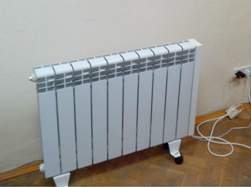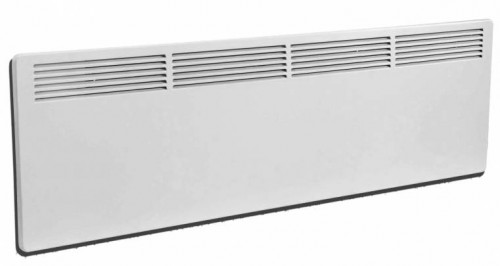Categories: Electrical Reviews
Number of views: 6598
Comments on the article: 1
Electroconvectors for home heating
 Along with home heating systems by means of boilers requiring constant fuel supplies, there is also a simpler heating method - using electric convectors. The name of the device (electric convector) speaks for itself - electrical energy is converted into heat, and heat, in turn, is transferred through the room due to natural air currents. So from the stationary wall convectors can be mounted a complete heating system for the home.
Along with home heating systems by means of boilers requiring constant fuel supplies, there is also a simpler heating method - using electric convectors. The name of the device (electric convector) speaks for itself - electrical energy is converted into heat, and heat, in turn, is transferred through the room due to natural air currents. So from the stationary wall convectors can be mounted a complete heating system for the home.
All electroconvectors are divided into floor and wall (stationary), but both are similar in design. These devices have a hollow, metal conduction conduit, in the lower part of which is located low-temperature heating element equipped with a plate radiator.
This is done so that the cold air entering through the lower inlets can be heated, flowing around radiator TENA, and rising up, exit through the openings in the upper part of the body of the electric convector, spread around the room, and heat it. For heating large rooms, convectors with a built-in fan that accelerate heat transfer are used.
Despite some similarities with oil radiators, electroconvectors have a significant difference from them: the maximum temperature of the heater in the electroconvector does not exceed 100 ° C, and the casing of the device does not heat above 60 ° C. This gives electric convectors a clear advantage over both oil coolers and electric fireplaces in terms of safety and economy.
In addition, there is a safety system in electric convectors that is triggered when a foreign object enters the heater or if hot air does not pass through the device as it should.
Among other advantages, it is worth noting that the electroconvector is very easy to install, and is easily accessible both for after-sales service and for replacement.
The heating elements of modern electric convectors are a steel tube in which an incandescent filament is placed, combined with an aluminum radiator, and some models have two heating rods, which makes it possible to choose the power - turn on the device either half or full power. There are, of course, inexpensive convectors on sale, in which the heater is just an open spiral, but we must understand that such devices have a much lower protection class.
The most reliable are convectors, in which the heater and radiator are combined in one unit. Different manufacturers use their own special ways of improving the heating elements, for example, the Norwegian company NOBO installed an incandescent filament in a quartz bed, and the service life of their heating elements now reaches 20 years.

Electroconvectors have different sizes, and are divided according to this criterion into three groups: narrow baseboards (up to 200 mm high), medium (no more than 330 mm high), and high (up to 650 mm high). The width can also be different, from 295 mm to 2500 mm, and this already depends, as a rule, on power.
The thickness of electroconvectors does not exceed 90 mm. Power ranges from 0.5 kW to 3 kW in increments of 250 watts, with weights of about 3 to 9 kg. Of course, both power and weight are related to the dimensions of the device, for example, high electroconvection panels have significant traction and their width is insignificant, and skirting boards for installation under windows and stained-glass windows are made long because the temperature of the heating elements in them is lower in order to maintain heat dissipation.
It is important that the set room temperature can be maintained with great accuracy by means of a thermostat, the convector will turn on and off when the air has cooled down a little or has already warmed up enough, which contributes significantly to energy saving.The most advanced electroconvectors have the ability to program to set any operating modes. For example, you can set the heating of a country house for trips there only on the weekend, or use the anti-freeze mode to prevent possible accidents in the absence of the owners.

Advanced manufacturers of electroconvectors have already built into some of their models the ability to control from a plug-in programmer so that several convectors in different rooms of the house, in fact an autonomous heating system, can be controlled in predetermined modes. A whole network of electric convectors can be built in the house, controlled from a central console or even from a cell phone.
If you install a home heating system based on electric convectors, the installation costs will not exceed $ 8 per 1 square meter of heated area, which is much cheaper than installing underfloor heating or boilers, and at the same time, installation takes much less, because you only need wiring. The calculation of the required power is quite simple: 40 W per cubic meter of a heated room with good thermal insulation, and some margin if the thermal insulation is poor, or if the glazing area is large.
See also at bgv.electricianexp.com
:
